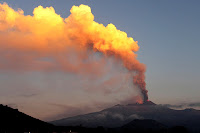Italy's Mount Etna volcano underwent a spectacular eruptive episode on the morning of Thursday 3 December 2015, producing an ash column over 3 km in height and lava fountains that reached about 1600 m above the summit, in an eruptive episode that lasted about an hour. This is the largest eruption on Etna this year, and came from the Voragine Crater, which has been inactive for some years, most recent eruptions having originated from the Southeast Crater. Ash falls were recorded in several areas in Sicily and south Italy.
Eruption on Mount Etna on 3 December 2015. Marco Restivo/Barcroft Media.
Etna first erupted about half a million years ago, beneath the sea off
the east coast of Sicily, and has been going strong ever since. It now
stands 3330 m above sea level, and covers 1200 km³. It is responsible
for fertile soils across eastern Sicily. Records of eruptions on Etna go
back to 1500 BC. It is Europe's second largest volcano, after Teide in
the Canary Islands, and is one of the most active volcanoes in the
world.
Ash column over Mount Etna on 3 December 2015, seen from Taormina on the east coast of Sicily. Giovani Isolino/AFP.
Despite all this Etna has only ever
caused 77 recorded deaths (the most recent being two tourists caught in a
summit explosion in 1987) and relatively little destruction. In 1928 it
destroyed the village of Mascali on its northeastern flank, though
there were no reported casualties, the village being slowly overrun by a
lava flow. In 1669 a much larger lava flow destroyed at least 10
villages, reaching the walls of the city of Catania, 40 km to the south,
but again without loss of life. In 122 BC a heavy ash fall covered much
of the region, causing several buildings to collapse in Catania. The
destruction was deemed so severe by the Roman authorities that they
granted the city a 10 year tax holiday. In about 6000 BC a landslide on
the eastern flank of the volcano is thought to have caused a tsunami
that caused destruction around much of the eastern Mediterranean.
Ash column over Mount Etna on 3 December 2015, seen from Catania on the east coast of Sicily. Davide Caudullo/EPA.
Etna
is located on the border of the African and European Plates,
specifically where Africa is being subducted beneath the European Plate.
As it is drawn into the Earth's interior material from the African
Plate melts, and the lighter portions rise up through the overlying
European Plate, causing a number of volcanoes including Etna and
Vesuvius.
See also...
 Volcanic activity on Mount Etna. The Osservatorio Etneo at the Istituto Nazionale di Geofisica e Vulcanologia
reported the beggining of a new phase of volcanic activity on Mount
Etna, an active volcano on the island of Sicily beginning on Tuesday 12
May 2015 with a series of Earth tremors beneath...
Volcanic activity on Mount Etna. The Osservatorio Etneo at the Istituto Nazionale di Geofisica e Vulcanologia
reported the beggining of a new phase of volcanic activity on Mount
Etna, an active volcano on the island of Sicily beginning on Tuesday 12
May 2015 with a series of Earth tremors beneath... Eruptions on Mount Etna. Mount Etna, Europe's most active volcano, located on the east of the
island of Sicily, underwent a series of large eruptions overnight on
Saturday 16-Sunday 17 November 2013, throwing lava and iridescent rocks...
Eruptions on Mount Etna. Mount Etna, Europe's most active volcano, located on the east of the
island of Sicily, underwent a series of large eruptions overnight on
Saturday 16-Sunday 17 November 2013, throwing lava and iridescent rocks... Eruption on Mount Etna. Mount Etna, a 3320 m active stratovolcano on eastern Sicily, erupted on
Saturday 26 October 2013, producing an ash column which briefly closed
airspace over the island and and throwing hot ash and lava out of its
crater. This follows a series of small...
Eruption on Mount Etna. Mount Etna, a 3320 m active stratovolcano on eastern Sicily, erupted on
Saturday 26 October 2013, producing an ash column which briefly closed
airspace over the island and and throwing hot ash and lava out of its
crater. This follows a series of small...
Follow Sciency Thoughts on Facebook.



